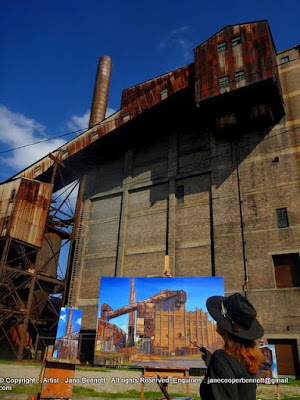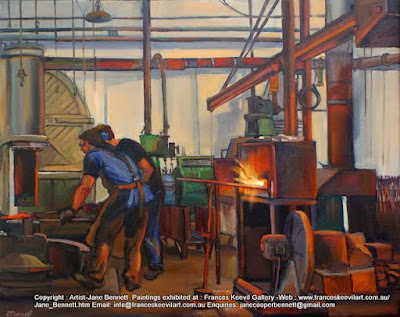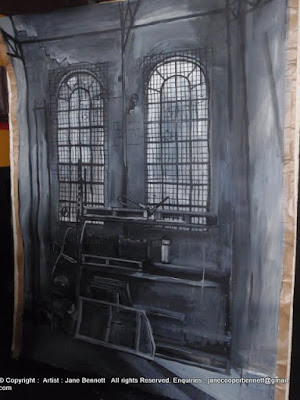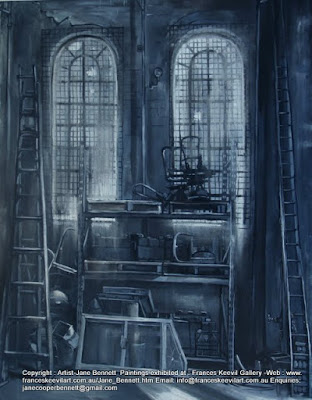"May close without warning"
at the Frances Keevil Gallery
11 - 30 OCTOBER 2011
info@franceskeevilgallery.com.au
'May Close without warning...'
My paintings and drawings are accompanied by some excerpts from "The Meanings of Deindustrialization"
by Jefferson Cowie and Joseph Heathcott, Saint Louis University 2003
Faculty Publications - Collective Bargaining, Labor Law, and Labor
History. Paper 33
 |
| Painting 'en plein air' "White Bay Power Station " 2011 oil on canvas 102 x 152cm Sold Enquiries about similar paintings |
"The point of departure for any discussion of deindustrialization must be respect
for the despair and betrayal felt by workers as their mines, factories,
and mills were padlocked, abandoned, turned into artsy shopping spaces, or even dynamited."
 | |
| "White Bay Power Station " 2011 oil on canvas 102 x 152cm Sold Enquiries about similar paintings |
"While economists and business leaders often speak in neutral, even hopeful, terms such as "restructuring," "downsizing" or "creative destruction," metaphors of defeat and subjugation are more appropriate for the workers who banked on good-paying industrial jobs for the livelihoods of their families and their communities..."
 | ||
Painting 'en plein air' "White Bay Power Station Chimney stacks" 2011 oil on canvas 51 x 25cm
"In fact, the first public use of the term "deindustrialization" identified the Allies' policy toward Germany just after World War II: an active process of victors stripping a vanquished nation of its industrial power." |
 |
| "White Bay Power Station Coal Loader" 2011 oil on board 35 x 28cm |
"The dramatic evidence of industrial change and capital flight that litters our landscapes does, however, present a basic collective problem: How do we account for the destruction of an economic order that seemed so rooted and pervasive?"
 |
| "Industrial Cathedral" charcoal drawing on paper 131 x 131 cm |
This drawing was a finalist in the 1998 Dobell Prize for Drawing (Art Gallery of N.S.W.) ; Finalist in 1998 Blake Prize for Religious Art ; Winner of 1998 Hunter's Hill Open Art Prize
"In the end, what may be most troubling about these ruined industrial landscapes is not that they refer to some once stable era, but rather that they remind us of the ephemeral quality of the world we take for granted."
 | ||
| "Grabber, Muncher, Ripper" 2010 oil on canvas 31 x 31 cm |
Outside the derelict wharf, the demolition
team waited patiently for all the preliminary drilling and checks to be
completed before they got the green light to start.
The parrot beaks of
the excavation attachments and their scarred and scaly skin reminded me
of the animated re-creations of Tyrannosaurus rex.
These
particular attachments are actually really called "Munchers"! The names
of other attachments eg. "Buckets", "Grabbers", "Rippers" and
"Pulverizers" are also reminiscent of comic books and children's toys.
"If Karl Marx was right in saying "all that is solid melts into air," then the industrial culture forged in the furnace of fixed capital investment was itself a temporary condition. What millions of working men and women might have experienced as solid, dependable, decently waged work really only lasted for a brief moment in the history of capitalism."
 | |
"Dave and Lok forging at 'Wrought Artworks', Eveleigh Railway Workshops" 2010 oil on canvas 36 x 46cm
Enquiries |
"Because capital was fixed in giant machines bolted to the floors of brick-and-mortar factories, the industrial culture that emerged in various places at various moments had an aura of permanence, durability, and heritage....."
 |
| Panorama
drawn from the top of the silos of the "Mungo Scott Flour Mills, Summer Hill" 2010 charcoal, ink and gouache on paper 118 x 118cm |
The
Operations of these flour mills have been transferred to Picton, on the
periphery of the south western suburbs, about 2 years ago. Now this
mill will be redeveloped into an apartment complex similar to other
former mills in Dulwich Hill and Newtown.
 |
| "Forging chisels (Drawing down), 'Wrought Artworks' Eveleigh Railway Workshops" 2011 oil on canvas 122 x 152cm |
"Working people saw in the decline of this industrial order the dissolution of their society, culture, and way of life, and the betrayal of their trust by those whose decisions shaped their fate."
Related posts




















